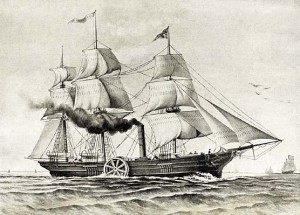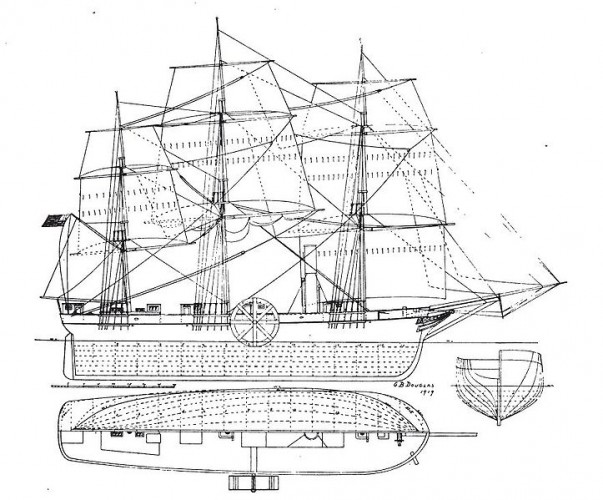New London‘s advantageous location on Long Island Sound made it a center for innovation in the transportation of goods and services by sea. As ocean transportation’s age of sail evolved into one of mechanical power, steamships made regular runs between New London and port cities like New Haven and New York. Consequently, it is fitting that it was two New London men, Moses and Stevens Rogers, who pioneered the use of steamships for transatlantic travel.
The SS Savannah was a hybrid sailing ship built in New York in 1818. During its construction, New London sea captain Moses Rogers persuaded the shipping firm Scarborough & Isaacs in Savannah, Georgia, to purchase the ship, convert it to steam power, and sail it across the Atlantic Ocean. Rogers oversaw the installation of the ship’s engine while he recruited his brother-in-law, Stevens Rogers, to oversee the construction of the ship’s hull and rigging and eventually become the ship’s Sailing Master.

First steamship to cross the Atlantic, SS Savannah
Transatlantic passage was dangerous in the early 19th century, and the addition of the untested ability to accomplish the task by steamship only increased that danger. Consequently, Moses and Stevens Rogers were unable to find a crew in New York willing to undertake the risky passage. The two men had to travel back to New London where Moses’ reputation as competent sea captain helped the two men find the right crew for their journey.
With a full crew, the ship headed to Savannah to prepare for its voyage across the Atlantic. On May 11, 1819, President James Monroe visited the SS Savannah, just prior to its departure, to take a brief excursion on the vessel that was about to make history.
Unable to find passengers willing to risk traveling by steam power on the open seas, the ship and her crew left Georgia in May of 1819 on their experimental mission to Europe. While the fully-rigged ship proceeded under steam power for parts of most days, it ended up being traditional sail power that carried the Savannah through most of the journey. The ship arrived in England in June of 1819 before traveling on to Denmark, Sweden, and Russia.
In spite of the acclaim the ship received for its historic voyage, the SS Savannah saw little commercial success as a steamship once it returned to the US. After Scarborough & Isaacs suffered a financial setback from a fire that swept through the city of Savannah in 1820, the firm sold the ship’s engine for $1,600 and converted the ship to a sailing packet used for travel between Savannah and New York.
On November 5, 1821, the SS Savannah ran aground off Long Island, breaking up a short time later. It was another 20 years before steamships made regular crossings of the Atlantic—and almost 30 years before an American ship duplicated the feat.









